Soil for new pine trees
I currently have several young trees in containers outside including Bristlecone (Pinus aristata) and Ponderosa (Pinus ponderosa) pine trees. I am also trying to grow Whitebark pine trees (Pinus albicaulis) from seed. I am thinking about getting a few more Bristlecone Pines and have been researching extensively on soil. I would like to try and find seeds or young trees of the Pinus longaeva variety as well if possible.
From what I have read, many people here like Al's Gritty Mix for aeration and drainage. Would this be a good mix for this type of tree and also for the Whitebark pines? If this works, any recommendations for fertilizing? I planted my existing trees in MG Moisture Control mainly because at the time I was thinking about the dry weather that can sometimes last for months on end. Early this year, some of the established trees in the forest here that are drought resistant had started turning yellow due to months with little to no moisture. My new trees seem to be doing good for now and the soil seems to retain moisture well without being overly damp. For my existing trees, I can look at changing the soil out next spring with Al's mix or another mix.
The Ponderosa trees I will eventually replant in the ground but the root balls were very small when I got them and was worried that the wind would rip the trees out of the ground so I put them in containers to start with. The Bristlecone trees appear to be very slow growing so I may keep them in containers for some time to protect against wind and wild animals.
Thanks.
Comments (19)
ken_adrian Adrian MI cold Z5
10 years agohey .. welcome..
by the title.. i almost went off on my usual.. no amendments to the SOIL rant ... and had to reread 3 times until i saw the container part ...
that is why i call stuff in pots media .. or medium ...
your location is so unique ... i hazard to give you any answer ...
but i usually suggest a bagged cactus mix as a starter .... its porosity .. drainage.. is what most trees enjoy ....
the seed part makes it a bit trickier though .... i might add some regular peat media.. to increase water holding capacity for seeds ... w/o a root system ... you need a bit more capacity ...
just keep as baseline info.. that trees... like a sip of water.. and near drying before more water .. if you treat them like annuals/perennials ... they will most likely die ...
and i would NEVER put a small pot.. in full sun ... the pot can warm too much ...
but if you can figure out how to have the trees in full sun... but not the pot.. you should be good ... i sometimes accomplish this.. by standing the pots in a group .. and using mulch to cover the pots ... its often seen in good nurseries... this keep the roots/pot cool ... add ambient humidity .. etc ...
also ... it sounds like you have some 2 or 3 year old seedlings.. frankly.. they are ready for mother earth.. i dont know why you want to complicate your life by potting them .... but i dont know how far you are pushing your micro climate.. with the plants you list .... that might make the pot risk worthwhile ....
the problem i see with the Al's mix.. is the shear bulk of most recipes ... these peeps make it by the wheelbarrow full ... and many of us.. dont need that much ... though if allowed to dry completely.. i have stored media in a plastic garbage can for decades ...
anyway.. spot on.. on understanding that the media is your base issue with trees/conifers in pots ...
i will read.. with interest.. how my ideas may vary.. according to your locale ..
ken
ps: all that said.. with many small pines... but not the ones you mention.. i have never met a pine in a pot.. that didnt like going bone dry in a pot before watering ... so my gut tells me .... and mind you.. sometimes my gut lies to me ... do not let them stand around sopping wet ...
pps: i do have aristata in my mineral sand.. well established.. and it has been bulletproof in two years of drought.. with NO WATERING ...
Related Professionals
Rossville Landscape Architects & Landscape Designers · Woodinville Landscape Architects & Landscape Designers · Avocado Heights Landscape Contractors · Bridgeport Landscape Contractors · East Patchogue Landscape Contractors · Fairhope Landscape Contractors · Golden Landscape Contractors · Haverhill Landscape Contractors · Lady Lake Landscape Contractors · Lantana Landscape Contractors · Lyndhurst Landscape Contractors · Madera Landscape Contractors · Merced Landscape Contractors · Pacifica Landscape Contractors · San Carlos Park Landscape Contractorsgreenman28 NorCal 7b/8a
10 years agoHello!
Al's Gritty Mix is certainly an exceptional mix.
But for your purposes, I think something like the 5-1-1 would be even better. It's a bark-based mix, durable for at least two years, holds more moisture than the Gritty Mix, weighs less, is easier to make, and costs significantly less. All you need is a source of quality pine or fir bark (I use fir bark, packaged as Greenall Micro Bark), then add in the requisite portions of Perlite and Peat (you can substitute Potting Mix for the Peat component). A slow-release fertilizer is recommended, and regular fertilizations with a liquid fertilizer throughout the growing season.
All of my potted conifers are in some variation of a bark-based mix, including the conifers that I've started from seed. The closest to Ponderosa that I've started is the higher elevation Jeffrey Pine.
If these were more mature specimen trees, such as candidates for bonsai, or if you were intending to keep them containerized indefinitely, then I would heartily recommend the Gritty Mix (as it is more durable than 5-1-1 and holds less moisture, thus reducing chance of root-rot).
Josh
ken_adrian Adrian MI cold Z5
10 years agojosh notes it weighs less ..
great idea if you are moving hundreds or thousands of pots a day ...
but i would qualify that trees.. once past the seed stage ... can grow a bit fast.. and tip over.. if the media is too light ...
but then.. i wouldnt have seedlings in pots after a year or two ...
the alternative.. is to have multiple pots in a nursery tote [boy thats a useless search term] .. that hold them upright .... or grouped together.. to hold each other up ...
ken
azhighcountry
Original Author10 years agoFor the 5-1-1, what are some other good alternatives to peat moss in addition to potting mix? From what I have read, Coconut Coir has similar characteristics. Would this work?
I have the Foliage Pro 9-3-6. Would that be okay for a fertilizer instead of adding a slow release fertilizer to the mix?
Thanks for the suggestions.
greenman28 NorCal 7b/8a
10 years agoKen,
yes, the 5-1-1 does weigh less...*than* Gritty Mix. It is still quite weighty when saturated. In an appropriately sized container, there shouldn't be any problems with blow-overs. And, in Arizona, one should opt for a slightly larger pot, anyway, to act as a moisture buffer on those hot days.For the 1 part peat, AZ, you could substitute potting mix, good compost, coir, or turface, pumice, et cetera. The function of the peat is to increase moisture retention and help "bind" the other ingredients together. Coir will serve that purpose. Wet it ahead of time so that it mixes better.
Adding in the slow-release fertilizer when you make the mix will provide a starter charge for your trees, and will also provide some nutrients during those first few months if you fail to fertilize regularly. If you are able to fertilize every 2 weeks, then you don't need to use the slow-release. I, too, rely exclusively on Foliage Pro for my soluble fertilizer - one stop nutrition, very easy and complete.
Josh
azhighcountry
Original Author10 years agoThanks for the suggestions. I think I found the ingredients that I want to use for the 5-1-1 on E-bay with free shipping for all of them. I rarely can seem to find what I am looking for locally so I generally order online to avoid frustration and wasting fuel. I hope the 5-1-1 mix will also be able to drain well to minimize the possibility of root rot.
I also want to pickup a small batch of the gritty mix to start with for some cactus seeds and indoor citrus trees and seeds. I found two places that sell a pre-mixed batch which I am thinking of going with short term and then next spring or summer, creating my own mix. I have been able to find the Turface at NAPA but I have no idea on the crushed granite. Perhaps I will try the pine seeds in both mixes to compare.
Here is a picture of several of my Ponderosa Pine trees. All of them and especially one has quite a few brown needles at the trunk. I am hoping this is just the standard shedding of older needles in fall and not another issue going on. I brought them in doors for a day as we have been getting light snow and harsh wind. They are probably big enough to go in the ground at this point but I worry that the rabbits will eat them. The rabbits like eating the small trees and shrubs due to lack of other vegetation. I have to say that they have grown quite a bit in a few months via the miracle gro mix but I still worry about excessive moisture retention.

ken_adrian Adrian MI cold Z5
10 years agoyes, the 5-1-1 does weigh less...*than* Gritty Mix. It is still quite weighty when saturated.
==>> yes.. but trees/conifers... should not be saturated very often ....
live and learn.. if they start falling over.. then they get planted in mother earth as they should be ... or up-potted ...
yes.. the brown ones all look like seedling needles ... those that first appeared the year it sprouted ... the next years growth ... is the 12 inches above ...
life is all in the bud .. and when it or the needles surrounding it start to change color ... that is when there is trouble ...
those pines really need to get in the ground.. if they grow another foot.. next spring... can you conceptualize how pot bound they will be by next fall ...
if it were me ... i would plant them in april... as soon as the ground thawed for me... and figure out how to defeat the rabbits ... [namely a few stakes and some chicken wire ...]
personally.. i would not fert with fresh media ... and very sparsely the second year.. if the same media were to be used... you should simply NOT be watering conifers so much.. that everything is running out the bottom ... [professional nurserymen have much differing opinions when dealing with thousands of pots for profit]
you need to get the mind set.. that you are HOLDING them in these pots .. not GROWING them in these pots ... one is a short term goal [even if it is a year or two] ... whereas the latter is a long term goal ...
keep us posted... we have lots of opinions to share ...
ken
Toronado3800 Zone 6 St Louis
10 years agoTo get around the root cooking problem I try to place anything I am holding over in a pot in one step more shade than the tree would ideally want. I have always meant to construct a sun barrier, be it with the fabric or just a two or three foot sheet of random plywood. This I would erect where it shades the pot but not the tree. Of course every month you would have to move the pot or it slightly as sun angle changes.
greenman28 NorCal 7b/8a
10 years agoKen,
it sounds as though you are somewhat unfamiliar with the 5-1-1 as a potting medium, and I mean that with no disrespect. When I say saturated, I mean at full moisture capacity - and that *is* something you should do *every* time you water the 5-1-1 (or the Gritty Mix, for that matter). These mixes will dry in a timely fashion. They offer superior drainage and aeration, and even when fully saturated (all particles holding maximum moisture) there is plenty of oxygen in the mix. One point of these mixes is the regular flushing that keeps salts (total dissolved solids) from accumulating in the media. By the same token, fresh nutrients need to be added to maintain full growth potential.A lot of the "rules of thumb" regarding container culture, repeated throughout GardenWeb, are based on the use of heavy, peat-based, poorly draining mixes. Much of that information can be tossed to the wayside when using a higher quality mix. If one were to treat the 5-1-1 as one treats a Miracle Grow mix - watering in sips, fertilizing infrequently, the results would be discouraging. These mixes are more work, yes, but they offer greater vitality to the trees we pot on or transplant into the earth.
Another benefit is how loose the mix is around the roots. When re-potting or transplanting, the mix falls away from roots with minimal trauma and thus reduces transplant shock. It is much easier to correct circling, girdling, hooked, or old woody roots in these mixes.
AZ, your trees look nice. I agree, typical needle shedding and nothing to fear at this point. If you intend to transplant soon, I wouldn't bother re-potting them. If they'll spend another year in containers, I would definitely make the effort to get them into a better mix for the next growing season. One thing you can do right now is to elevate the container in the drip-tray so that air is circulating below the pot. This will help the mix dry more evenly. If you have wine-corks, lay several on their sides in the drip-tray as spacers.
Josh
ken_adrian Adrian MI cold Z5
10 years agoit sounds as though you are somewhat unfamiliar with the 5-1-1 as a potting medium, and I mean that with no disrespect.
==>> you are correct .. and none taken .... anything that furthers the conversation is a positive ... i am not concerned if you know more than me.. and want to teach he and me at the same time .....
one of my favorite themes is that words mean things ...
and then i think about peeps ..... who are not as high on the learning curve.. misunderstanding the words we use ...
so .. to be clear.. IN MY EXPERIENCE ... trees in pots.. need to near dry .. in between a good watering ...
trees.... conifers... shrubs.. should not be treated like annuals/perennials ... and kept somewhat sodden ...
and the whole point of perfecting the media.. whatever the choice is... is that it sheds water .. what we call DRAINAGE... when planting in mother earth ....
so josh .. we are agreeing in toto.. as far as i am concerned.. and i am trying to simplify the thought process for the less educated ...
BTW... are you suggesting alcoholism will help trees grow in pots.. lol ....
OP is in good shape.. because he has identified a variable.. media... and is working to perfect such ...
now all he has to figure out.. is how to give the plant full sun .... without the pot itself cooking in full sun .... and that should be pretty easy ...
ken
azhighcountry
Original Author10 years agoI have been savings bottle caps of different sizing and using those to elevate the containers for the Pines. I am also doing this for my Citrus now. This seems to be working well so far. I also received a gallon of the FP 9-3-6 so I should be good for fertilizer for a while. I need to think a bit more into the best method for blocking sunlight to the containers but not the trees.
I think I can locate some of the ingredients locally for the 5-1-1 and Gritty mix but I am undecided on the bark choice. I found a bark called Orchiata Pinus Radiata bark that people on other forums seem very happy with due to being long lasting, having modified PH level, excellent porosity, and little waste. There are sizes available down to 1/8". The only downside I could find is the price. 10+ gallons with shipping would cost around $70. The bark itself is not too expensive but the shipping is expensive. The second option would be to buy the Repti Bark from a local pet store.
On a side note, I found a potential source for both Pinus balfouriana and longaeva seeds that should hopefully be available in the next several months. I ordered a variety of new seeds from the same source. Since I am at high elevation, I am going for all the high elevation pines and also Cottonwood, which grows very well here also.
Pinus ponderosa subsp. scopulorum, ponderosa var. brachyptera, strobiformis, flexilis, albicaulis, aristata, and Populus deltoides
I ordered small clear cylinder containers that I want to modify for use of cold stratification. I am excited to see if I can get some of these seeds to germinate.
This post was edited by azhighcountry on Sun, Nov 3, 13 at 18:28
greenman28 NorCal 7b/8a
10 years agoOrchiata is good stuff from what I've seen. As with the Repti-Bark, price is the downside. Also, Repti-Bark tends to be a bit large, so there's some waste after screening.
Optimally, the bark will be in a range of particles from 1/2 inch down to bark dust, with the average particle size being about 1/4 inch. Al (Tapla) recommends "composted" bark, but I find that uncomposted bark works very well for conifers and lasts longer, too. The only trade-off is that you need to keep up with the nutrients in case of Nitrogen binding.
Josh
azhighcountry
Original Author10 years agoHello,
I wanted to give an update. I have had very high germination rate using NAPA Diatomaceous Earth sifted fines. I have 27 new seedlings of type Pinus flexilis, strobiformis, ponderosa brachyptera, and ponderosa scopulorum. I have not had much success yet with albicaulis but have a new batch in a longer cold stratification period at 77 days now.
I made a mix of modified 5-1-1 with Orchiata classic, very coarse Perlite, and DE in place of Peat Moss. The Orchiata bark ranges in size from 1/8" - 1/2". I also moved some of the DE fines over when I moved the seedlings into separate cups. I did not add a CRF. I mix a gallon at a time with Foliage Pro 9-3-6 and water daily. This 5-1-1 mix has excellent drainage.
Everything started out well but now two of the first pine seedlings have brown tips on the first set of needles. Do you have some suggestions as to why this is happening? Could it be over or under watering? Perhaps too much or too little fertilizer? The trees are inside for the moment but do get some daily sunlight. I was hoping to put them outside when it warms up a bit at night.
Here are several images of my seedlings including the ones with the brown tips.

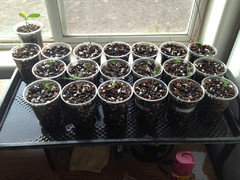

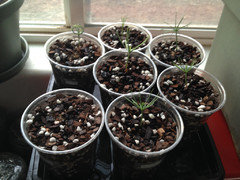
Thanks!
Jeroen
This post was edited by azhighcountry on Fri, Jan 24, 14 at 19:22
ken_adrian Adrian MI cold Z5
10 years agoi wouldnt be fertilizing them at all ... but that i doubt that is the problem...
what is the ambient humidity in the house ...
and what direction is that window facing.. could they be frying in intense afternoon sun ... i dont understand your words.. are they periodically going outdoors??? .. if so.. i would NOT allow any direct sun ... even full bright shade.. is more intense than thru the window .... and that is all i would allow ... full bright shade ...
your media is brilliant .... congrats ...
in my sand.. self sown ... that is about it for the first year.. on pine seedlings ... mostly sylvestris and some picea glauca ... and IMHO ... you are not going to change genetic growth rates thru hyper-fertilizing ... and you really should not be watering so heavily that you are leaching the media .... most of the work is being grown underground;. building the root mass .... which.. you will actually be able to see.. go figure on that.. lol ...
germination was the easy part.. you succeeded ... now dont screw it all up.. by killing them with too much love ....
do you know how to properly HARDEN THEM OFF .....when the time comes????
ken
ps: i would never put.. that small a pot... in full sun ... just to hard to maintain proper watering ....
mikebotann
10 years agoOne way to keep potted plants cool in the sun is to put them in a larger empty pot. I have plenty of pots from buying plants for landscape jobs over the years and keeping the pots. A row of empty pots in front of a row of full pots with plants in them works too.
I have visited the Arizona high country in the summer several times. My friends think I'm crazy. Who goes to Arizona in the summertime? There's a big difference between low and high in Az. The temps are mild, the meadows are green, and I enjoyed it very much. I stayed a week in Heber-Overgaard, south east of Flagstaff both times. Petrified forest, Meteor Crater, Painted Desert, etc. Plenty to see.
Mikegreenman28 NorCal 7b/8a
10 years agoExcellent work!
I think the brown tips are probably from the indoor environment, but there could be other causes we need to rule out.
First, watering daily is too much. Fertilizing daily is too much.
Overwatering can lead to browned tips as the root tips die from lack of oxygen. Too much fertilizer can also burn roots (excess build up of salts in the mix), leading to browned tips - this is exceptionally common with houseplants.
At this time of year, and this stage of development, I think I'd be fertilizing once every two weeks at most. Also, reduce the Foliage Pro dosage if you aren't already...I go with a 1/4 strength dose during the Winter.
Josh
azhighcountry
Original Author10 years agoKen,
I have an indoor environmental monitor and since 01-11-14, the ambient temperature has ranged from 68-82F with a peak temperature of 84F. The relative humidity has ranged from 5-6% with a rare instance at 7%. We are going through another dry spell.
The window is west facing and the seedlings have been getting a few hours of sun through the window in the afternoon hours. I have not put the seedlings outside to date. Today I moved the seedlings out of the direct sunlight and hopefully this will help out. I will also cut back on watering and fertilizing.
From the research I have done, the pine seedlings need some cold hardening. If you have some methods that have worked well for your pine seedlings and can share those, I would appreciate it. Thanks.
--
Mike,
Thanks for the suggestion. I do have quite a few extra pots left over from trees that I previously purchased that I could use for this purpose.
I very much like the Arizona high country. The weather conditions in places like Heber-Overgaard, Flagstaff, Williams, Happy Jack, and North/South Rim are vastly different from low elevation areas like Phoenix and Bull Head City and I love the forests up here.
--
Josh,
I think I have been overdoing it on the fertilizer and will scale back the fertilizing to every two weeks. Thanks for the suggested watering and fertilizing scheduling and dosage. I previously searched around to get an idea of dosage and frequency with the Foliage Pro but had trouble finding this information specifically for the pine seedlings.
Jeroen
greenman28 NorCal 7b/8a
10 years agoHey!
With seedlings, you can generally assume that "Less is more" when it comes to fertilization...especially during the Winter when the growth isn't as vigorous. During the Summer, full-strength every two weeks (during the prime growing season) should be fine. If you prefer to fertilize more often, you could always go 1/2 strength once a week.To harden off seedlings, just put them in outdoor shade. I think Mike mentioned setting them in larger pots - a good idea. I sometimes use a cardboard box for my seedlings, which protects from harsh drying wind (which will ravage tender seedlings as surely as too much light). I would begin the hardening process when temps are above 40F. Grey, rainy days are wonderful for hardening seedlings, too.
Josh






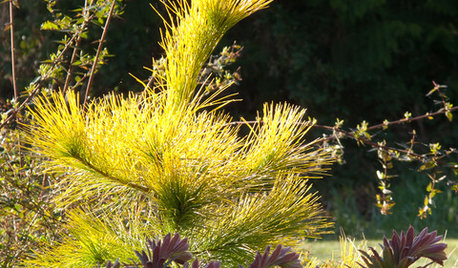
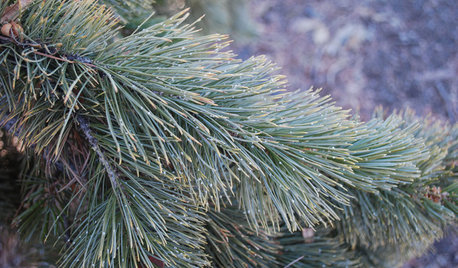
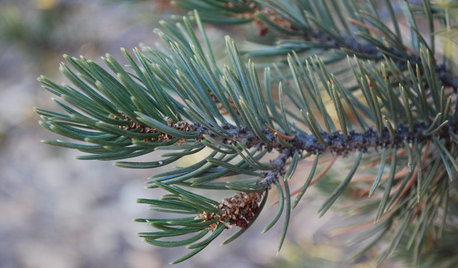










azhighcountryOriginal Author